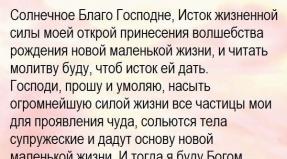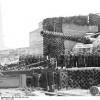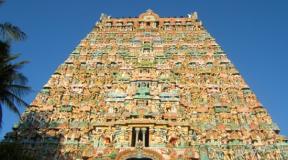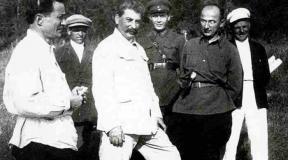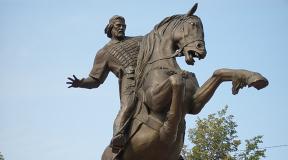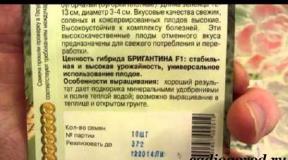Who owned the patrimony in Russia. What is a fiefdom and how does it differ from an estate? In specific period
In the 10th century, the first feudal lords appeared on the territory of Kievan Rus, who owned large land plots. At the same time, the word patrimony appears in Russian documents. This is a special legal form of ancient Russian land ownership. Until the end of the 13th century, the votchina was the main form of land ownership.
Origin of the term
In those distant times, land could be acquired in three ways: to buy, to receive as a gift, to inherit from one's relatives. The votchina in Ancient Russia is the land obtained by the third method. The word comes from the Old Russian "ottchina", which meant "property of the father." Such land could not be passed on to uncles, brothers or cousins - only inheritance in a straight line counted. Thus, the patrimony in Russia is the property transferred from father to son. The inheritance of grandfathers and great-grandfathers in a straight line fell under the same category.
Boyars and princes received fiefdoms from their ancestors. Wealthy landowners had several estates under their control and could increase their territories through redemption, exchange, or the seizure of communal peasant lands.
Legal aspects
An patrimony is the property of one specific person or organization. Communal and state lands did not have patrimonial rights. Although public ownership was of little importance at that time, it made it possible for millions of peasants to live, who cultivated these lands without the right to them.

The owner of the estate could make an exchange, sale or division of the land, but only with the consent of his relatives. For this reason, the owner of the estate could not be called a full-fledged owner. Later, the clergy joined the class of private landowners.
The owners of patrimonial lands had a number of privileges, especially in the field of legal proceedings. Also, the estates had the right to collect taxes, had administrative power over the people living on their lands.
What was included in the concept of patrimony
It is not necessary to think that the land passed by inheritance was only land suitable for agriculture. The votchina in Ancient Russia is buildings, arable lands, forests, meadows, livestock, inventory, and most importantly, peasants living on patrimonial land. In those days, serfdom as such did not exist, and peasants could freely move from the land allotments of one patrimony to another.

Boyar estate
Along with private and church land property, there was also a boyar estate. This is land given as a reward by the tsar to his personal servants - the boyars. The same rights were extended to the granted land as to a simple patrimony. The boyar patrimony quickly became one of the largest in Russia - the land wealth of the boyars arrived at the expense of expanding the territories of the state, as well as by distributing the confiscated property of the disgraced boyars.

Feudal fiefdom
This form of land ownership, as an estate, arose in the 13th century. The reason why the patrimony has lost its significance is of a legal nature. As you can see, during the fragmentation of Russia, service under the prince was not connected with land ownership - a free servant could own land in one place, and serve the boyar in another. Thus, the approximate position of any landowner was not reflected in any way in the amount of his land. Only the land paid, and only people served. The feudal patrimony made this clear legal division so widespread that the boyars and free servants, in case of improper care of the land, lost their right to it, and the land was returned to the peasants. Gradually, patrimonial land ownership became the privilege of servicemen who were subordinate to the king himself. This is how the feudal estate was formed. This land ownership was the most common type of land ownership; state and church lands began to expand their territories much later.

Emergence of estates
In the 15th century, a new form of land tenure emerged that gradually changed obsolete principles of land tenure such as the fiefdom. This change primarily affected landowners. From now on, their right to own and manage estates was restricted - only a narrow circle of people were allowed to inherit land and dispose of it.
In Muscovy of the 16th century, the word "patrimony" is practically not found in civil correspondence. It disappeared from word usage, and persons who were not in the public service ceased to be called votchinniks. The same people who served the state had the right to a land allotment called an estate. Servant people were "placed" on the lands for the sake of protection or as payment for service to the state. With the termination of the term of service, the land returned to the royal property, and later this territory could be transferred to another person for services to the king. The heirs of the first owner had no rights to the estate land.
Two forms of land ownership
The patrimony and the estate are two forms of land ownership in Muscovy in the 14th-16th centuries. Both acquired and inherited lands gradually lost their differences - after all, the same duties were imposed on landowners of both forms of ownership. Large landowners, who received land as a reward for their service, gradually won the right to transfer estates by inheritance. In the minds of many land owners, the rights of votchinniks and service people were often intertwined; there are cases when people tried to pass on estate lands by inheritance. These court incidents led to the fact that the state was seriously concerned about the problem of land ownership. Legal confusion with the order of inheritance of estates and patrimonies forced the tsarist authorities to adopt laws equalizing both of these types of land tenure.

Land laws of the mid-16th century
The most complete new rules for land tenure were set forth in the royal decrees of 1562 and 1572. Both of these laws limited the rights of the owners of princely and boyar estates. In private, cases of selling patrimonial plots were allowed, but the number was not more than half, and then only to blood relatives. This rule was already spelled out in the Sudebnik of Tsar Ivan and reinforced by numerous decrees that were issued later. The votchinnik could bequeath part of his lands to his wife, but only in temporary possession - "for a living". A woman could not dispose of the given land. After the termination of ownership, such patrimonial land was transferred to the sovereign.
For the peasants, both types of property were equally difficult - both the owners of the patrimony and the owners of the estates had the right to collect taxes, administer justice, and take people into the army.
Results of local reform
These and other restrictions outlined had two main purposes:
- maintain "their" service names and stimulate their readiness for public service;
- to prevent the transition of "service" lands into private hands.

Thus, the local reform practically abolished the legal meaning of patrimonial land tenure. The patrimony was equal to the estate - from legal and unconditional possession, the possession of land property turned into conditional property, directly related to the law and the desire of royal power. The concept of "patrimony" has also been transformed. This word gradually disappeared from business documents and colloquial speech.
Development of private land ownership
The estate became an artificial stimulus for the development of land ownership in Muscovite Russia. Huge territories were distributed to sovereign people thanks to local law. At present, it is impossible to determine the exact relationship between manorial and patrimonial lands - there were no accurate statistics on land. The increment of new lands made it difficult to take into account the existing possessions, which at that time were owned by private individuals and the state. Votchina is an ancient legal land tenure, at that time it was significantly inferior to the local one. For example, in 1624, the Moscow district consisted of about 55% of all available agricultural land. Such a quantity of lands needed not only a legal, but also an administrative apparatus of management. County noble assemblies became a typical local body for the protection of landowners.
County societies
The development of landownership caused the birth of county noble societies. By the 16th century, such meetings were already quite organized and acted as a significant force in local government. Some political rights were also assigned to them - for example, collective petitions to the sovereign were formed, local militia was formed, petitions were written to the tsarist authorities about the needs of such societies.
Estate
In 1714, the royal decree on uniform inheritance was issued, according to which all landed property was subject to uniform inheritance rights. The emergence of this type of landed property finally united the concepts of "estate" and "patrimony". This new legal formation came to Russia from Western Europe, where at that time a developed system of land management had already existed for a long time. The new form of land ownership was called "estate". From that moment on, all landed property became immovable property and was subject to uniform laws.
Votchina
Diploma of Peter the Great to Chancellor Golovkin for patrimony.
patrimony- land ownership owned by the feudal lord hereditarily (from the word "father") with the right to sell, pledge, donate. The estate was a complex consisting of landed property (land, buildings and inventory) and rights to dependent peasants. Synonyms for patrimony - allod, bockland.
During the Kievan Rus fiefdom was one of the forms of feudal land ownership. The owner of the patrimony had the right to pass it on by inheritance (hence the origin of the name from the Old Russian word "fatherland", that is, paternal property), sell it, exchange it, or, for example, divide it among relatives. Estates as a phenomenon arose in the process of formation of private feudal land ownership. As a rule, their owners in the 9th-11th centuries were princes, as well as princely warriors and zemstvo boyars - the heirs of the former tribal elite. After the adoption of Christianity, church patrimonial land ownership was also formed, the owners of which were representatives of the church hierarchy (metropolitans, bishops) and large monasteries.
There were various categories of patrimony: ancestral, bought, donated by the prince or others, which partially affected the ability of the owners to freely dispose of fiefdom. So, the possession of patrimonial estates was limited by the state and relatives. The owner of such an estate was obliged to serve the prince on whose lands it was located, and without the consent of the members of a kind of estate, the estate could not sell or exchange it. In case of violation of such conditions, the owner was deprived of the estate. This fact indicates that in the era of Kievan Rus, the possession of a fiefdom was not yet equated with the right of unconditional ownership of it.
The estates differed in economic structure (depending on the role of the domain, the type of feudal duties of the peasants), in size, and in the social affiliation of the estates (secular, including royal, church).
Wikimedia Foundation. 2010 .
Synonyms:See what "Votchina" is in other dictionaries:
Cm … Synonym dictionary
The term of ancient Russian civil law for designating landed property with the rights of full private ownership of it. In the Moscow kingdom, V. is opposed to the estate, as land property with the rights of conditional, temporary and personal ... ... Encyclopedia of Brockhaus and Efron
fiefdom- patrimony, history. Type of land ownership, possession, acquired or granted with the right to transfer by inheritance, with the right to sell, mortgage, etc. (See Sl. RYa XI XVII. 3. 74). And there is no end to this distant sovereign estate, no edge, ... ... Dictionary of the trilogy "The Sovereign's Estate"
1) the oldest type of landed property in Russia, which was inherited. It arose in the 10th and 11th centuries. (princely, boyar, monastic), in the 13th-15th centuries. dominant form of land ownership. From con. 15th c. opposed the estate with which she approached ... Big Encyclopedic Dictionary
VOTCHINA, type of land ownership (hereditary family or corporate ownership). It arose in the 10th and 11th centuries. (princely, boyar, monastic), in the 13th-15th centuries. main form of land ownership. From the end of the 15th century existed along with the estate, with which ... ... Russian history
Votchina- the term of Old Russian law, denoting landed property with the rights of full private ownership of it. Originated in Kievan Rus in the 9th-10th centuries. (V. princes and boyars). In the XI XV centuries. V. became the predominant form of feudal inherited land ownership. ... ... Encyclopedia of Law
1) the oldest type of landed property in Russia, which was inherited. It arose in the XXI centuries. (princely, boyar, monastic); in the XIII-XV centuries. dominant form of land ownership. From the end of the XV century. opposed the estate with which she approached ... ... Law Dictionary
VOTCHINA, the oldest type of landed property in Russia, a family estate that passed by inheritance. It arose in the 10th and 11th centuries (princely, boyar, monastic), in the 13th and 15th centuries the dominant form of land ownership. At the end of the 15th and 17th centuries, it differed from ... ... Modern Encyclopedia
patrimony, patrimony, wives. (source). In Muscovite Russia, the family estate of a large landowner (prince, boyar), passed from father to son. Explanatory Dictionary of Ushakov. D.N. Ushakov. 1935 1940 ... Explanatory Dictionary of Ushakov
patrimony, s, wives. In Russia until the 18th century: ancestral hereditary land ownership. | adj. patrimonial, oh, oh. Explanatory dictionary of Ozhegov. S.I. Ozhegov, N.Yu. Shvedova. 1949 1992 ... Explanatory dictionary of Ozhegov
A term used in Russian historical literature to designate a complex of feudal landed property (land, buildings, living and dead implements) and related rights to dependent peasants. Synonyms for patrimony are seigneuria ... Political science. Dictionary.
patrimony, a type of feudal land ownership. It arose in the Old Russian state in the 10th-11th centuries as a hereditary tribal (later and family) or corporate property (“fatherland”). The owners of the patrimony were princes, boyars, the church. The formation of Russian principalities and lands from the middle of the 11th century led to the fact that the inviolability of the estates-princes was confirmed by the Lubech Congress of 1097. In the 13th-15th centuries, the patrimony was the main type of land tenure, replenished in the process of developing new territories, as well as due to the seizure of communal black lands, grants, purchases, etc. The formation of the system of patrimonial land tenure in the Novgorod Republic was completed by the middle of the 14th century. From the end of the 14th century, an increase in the number of monastic estates in North-Eastern Russia began. In the 2nd half of the 15th century, a significant part of this territory was also covered by princely and boyar estates. Within the framework of patrimonial land tenure, there was no right of primacy. Most of the inherited lands were mortgaged, divided among numerous heirs, or sold and given to monasteries for posthumous commemoration. Votchinniki had a number of privileges (judicial, financial, etc.). In the 15th-17th centuries, along with the estate, there was an estate as a conditional form of land ownership. At the end of the 15th - beginning of the 16th century, many large landowners of the Novgorod and Pskov republics, the Grand Duchy of Tver were deprived of their estates by the Grand Dukes of Moscow. At the same time, the patrimonies of large monasteries grew (Trinity-Sergius, Joseph-Volotsky, Kirillo-Belozersky, etc.). There were patrimonial (“ancient”), purchased, and from the 1610s also served estates. Many estate owners lost their possessions during the period of the oprichnina, sold or mortgaged their estates, wanting to avoid their confiscation by the state. In the 1580s, monasteries were prohibited from buying or receiving fiefdoms from private individuals. In the 17th century, patrimonial land ownership began to grow again. The distinction between manor and patrimony gradually blurred in the 17th century. At the end of the 17th century, patrimonial land ownership significantly exceeded the estate. Decree of Tsar Peter I dated 23.3 (3.4). 1714 on the uniform inheritance legally formalized the final merger of the estate and the estate. Most of the monastic and church estates were liquidated during the secularization of 1764. In the 18-19 centuries, the term "patrimony" was used in relation to any hereditary land property, while maintaining the legal difference between the ancestral and acquired patrimony.
Lit .: Sergeevich V. I. Lectures and research on the ancient history of Russian law. 3rd ed. St. Petersburg, 1903; Veselovsky S. B. Feudal land tenure in North-Eastern Russia. M.; L., 1947. T. 1; Grekov B.D. Peasants in Russia. 2nd ed. M., 1952-1954. Book. 1-2; Cherepnin L.V. Formation of the Russian centralized state in the XIV-XV centuries. M., 1960; Ivina L. I. A large estate of North-Eastern Russia at the end of the 14th - 1st half of the 16th century. L., 1979; Yanin VL Novgorod feudal patrimony: (Historical and genealogical research). M., 1981; Kobrin V. B. Power and property in medieval Russia (XV-XVI centuries). M., 1985; Shvatchenko O. A. Secular feudal estates of Russia in the 1st third of the 17th century. M., 1990; he is. Secular feudal estates in Russia in the second half of the 17th century. M., 1996; he is. Secular feudal estates of Russia in the era of Peter I. M., 2002; Cherkasova M.S. Land ownership of the Trinity-Sergius Monastery in the XVI-XVII centuries. M., 1996; she is. A large feudal patrimony in Russia at the end of the 16th-17th centuries. (according to the archive of the Trinity-Sergius Lavra). M., 2004; Milov L.V. Great Russian plowman and features of the Russian historical process. 2nd ed. M., 2006.
The formation of the state among the Eastern Slavs was a logical result of a long process of decomposition of the tribal system and the transition to a class society.
The process of property and social stratification among the community members led to the separation of the most prosperous part from their midst. The tribal nobility and the prosperous part of the community, subjugating the mass of ordinary community members, needs to maintain their dominance in state structures.
The embryonic form of statehood was represented by the East Slavic unions of tribes, which united in superunions, however, fragile ones. One of these associations was, apparently, the union of tribes headed by Prince Kiy ( VI c.) There is information about a certain Russian prince Bravlin, who fought in the Khazar-Byzantine Crimea in VIII - IX centuries, passing from Surozh to Korchev (from Sudak to Kerch). Eastern historians talk about the existence on the eve of the formation of the Old Russian state of three large associations of Slavic tribes: Kuyaba, Slavia and Artania. Kuyaba, or Kuyava, then called the area around Kiev. Slavia occupied the territory in the area of Lake Ilmen. Its center was Novgorod. The location of Artania - the third major association of Slavs - has not been precisely established.
According to The Tale of Bygone Years, the Russian princely dynasty originates in Novgorod. In 859, the northern Slavic tribes, who then paid tribute to the Varangians, or Normans (according to most historians, immigrants from Scandinavia), drove them across the sea. However, soon after these events, internecine struggle began in Novgorod. To
to stop the clashes, the Novgorodians decided to invite the Varangian princes as a force standing above the opposing factions. In 862, Prince Rurik and his two brothers were called to Russia by the Novgorodians, laying the foundation for the Russian princely dynasty.
Norman theory
The legend about the calling of the Varangian princes served as the basis for the creation of the so-called Norman theory of the emergence of the Old Russian state. Its authors were invited to XVIII v. to Russia, German scientists G.Bayer, G.Miller and A.Schletser. The authors of this theory emphasized the complete absence of prerequisites for the formation of a state among the Eastern Slavs. The scientific inconsistency of the Norman theory is obvious, since the determining factor in the process of state formation is the presence of internal prerequisites, and not the actions of individual, even outstanding, personalities.
If the Varangian legend is not fiction (as most historians believe), the story of the calling of the Varangians only testifies to the Norman origin of the princely dynasty. The version about the foreign origin of power was quite typical for the Middle Ages.
The date of formation of the Old Russian state is conditionally considered to be 882, when Prince Oleg, who seized power in Novgorod after the death of Rurik (some chroniclers call him the governor of Rurik), undertook a campaign against Kiev. Having killed Askold and Dir, who reigned there, for the first time he united the northern and southern lands as part of a single state. Since the capital was moved from Novgorod to Kiev, this state is often called Kievan Rus.
2. Socio-economic development
Agriculture
The basis of the economy was arable farming. In the south, they plowed mainly with a plow, or ral, with a double team of oxen. In the north - a plow with an iron plowshare, drawn by horses. Cultivated mainly cerealsry: rye, wheat, barley, spelt, oats. Millet, peas, lentils, and turnips were also common.
Two-field and three-field crop rotations were known. The double field consisted in the fact that the entire mass of cultivated land was divided into two parts. One of them was used for growing bread, the second "rested" - was under fallow. With a three-field crop rotation, in addition to the fallow and winter field, a spring field also stood out. In the forest north, the amount of old arable land was not so significant, slash-and-burn agriculture remained the leading form of agriculture.
The Slavs kept a stable set of domestic animals. Bred cows, horses, sheep, pigs, goats, poultry. Crafts played a rather significant role in the economy: hunting, fishing, beekeeping. With the development of foreign trade, the demand for furs increased.
Craft
Trades and handicrafts, developing, are more and more separated from agriculture. Even in conditions of subsistence farming, home craft techniques are being improved - the processing of flax, hemp, wood, and iron. Actually, handicraft production already numbered more than a dozen types: weapons, jewelry, blacksmithing, pottery, weaving, leather. Russian craft in its technical and artistic level was not inferior to the craft of the advanced European countries. Jewelry, chain mail, blades, locks were especially famous.
Trade
Internal trade in the Old Russian state was poorly developed, since subsistence farming dominated the economy. The expansion of foreign trade was associated with the formation of a state that provided Russian merchants with safer trade routes and supported them with its authority in international markets. In Byzantium and the countries of the East, a significant part of the tribute collected by the Russian princes was realized. Products of crafts were exported from Russia: furs, honey, wax, products of artisans - gunsmiths and gold smiths, slaves. Mostly luxury items were imported: grape wines, silk fabrics, fragrant resins and spices, expensive weapons.
Craft and trade were concentrated in cities, the number of which grew. The Scandinavians who often visited Russia called our country Gardarika - the country of cities. In Russian chronicles at the beginning XIII v. more than 200 cities are mentioned. However, the inhabitants of the cities still retained close ties with agriculture and were engaged in agriculture and cattle breeding.
social order
The process of formation in Kievan Rus of the main classes of feudal society is poorly reflected in the sources. This is one of the reasons why the question of the nature and class basis of the Old Russian state is debatable. The presence of various economic structures in the economy gives reason to a number of specialists to evaluate the Old Russian state as an early class state, in which the feudal structure existed along with the slave-owning and patriarchal.
Most scientists support the idea of academician B.D. Grekov about the feudal nature of the Old Russian state, since the development of feudal relations began to IX v. leading trend in the socio-economic development of ancient Russia.
Feudalismcharacterized by the complete ownership of the feudal land and incomplete ownership of the peasants, in relation to whom he applies various forms of economic and non-economic coercion. The dependent peasant cultivates not only the land of the feudal lord, but also his own plot of land, which he received from the feudal lord or the feudal state, and is the owner of tools, housing, etc.
The beginning process of the transformation of tribal nobility into owners of the land in the first two centuries of the existence of the state in Russia can be traced, mainly, only on archaeological material. These are rich burials of boyars and combatants, the remains of fortified suburban estates (patrimonies) that belonged to senior combatants and boyars. The class of feudal lords also arose by singling out the most prosperous members of the community, who turned part of the communal arable land into property. The expansion of feudal landownership was also facilitated by direct seizures of communal lands by the tribal nobility. The growth of the economic and political power of the landowners led to the establishment of various forms of dependence of ordinary community members on landowners.
Population categories
However, in the Kiev period, there remained a fairly significant number of free peasants, dependent only on the state. The term "peasants" itself appeared in the sources only in XIV v. Sources of the period of Kievan Rus call the community members dependent on the state and the Grand Duke people or stinks.
The main social unit of the agricultural population continued to be the neighboring community - verv. It could consist of one large village or several small settlements. The members of the vervi were bound by collective responsibility for paying tribute, for crimes committed on the territory of the vervi, by mutual responsibility. The community (vervi) included not only smerds-farmers, but also smerds-artisans (blacksmiths, potters, tanners), who provided the needs of the community in handicrafts and worked mainly to order. A person who broke ties with the community and did not enjoy its patronage was called outcast.
WITHWith the development of feudal landownership, various forms of dependence of the agricultural population on the landowner appear. A common name for a temporarily dependent peasant was purchase This was the name of a person who received a kupa from the landowner - assistance in the form of a plot of land, a cash loan, seeds, tools or draft power and was obliged to return or work out the kupa with interest. Another term referring to dependent people is ryadovich, those. a person who has concluded a certain agreement with the feudal lord - a series and is obliged to perform various works according to this series.
In Kievan Rus, along with feudal relations, there was patriarchal slavery, which, however, did not play a significant role in the country's economy. Slaves were called serfs or servants. First of all, captives fell into slavery, but temporary debt bondage, which ceased after payment of the debt, became widespread. Kholops were commonly used as household servants. In some estates there were also so-called plowed serfs, planted on the ground and having their own
economy.
Votchina
The main cell of the feudal economy was the estate. It consisted of a princely or boyar estate and dependent communities-verveys. In the estate there was a yard and mansions of the owner, bins and barns with "abundance", i.e. stores, servants' dwellings and other buildings. Special managers were in charge of various sectors of the economy - tiunas and key keeper, at the head of the entire patrimonial administration was fireman. As a rule, artisans serving the lordly household worked in the boyar or princely patrimony. Craftsmen could be serfs or be in some other form of dependence on the votchinnik. The patrimonial economy had a natural character and was focused on the internal consumption of the feudal lord himself and his servants. The sources do not allow us to unequivocally judge the dominant form of feudal exploitation in the patrimony. It is possible that some part of the dependent peasants cultivated corvee, another paid the landowner in kind.
The urban population also fell into dependence on the princely administration or the feudal elite. Near cities, large feudal lords often founded special settlements for artisans. In order to attract the population, the owners of the villages provided certain benefits, temporary tax exemptions, etc. As a result, such craft settlements were called freedoms or settlements.
The spread of economic dependence, increased exploitation caused resistance from the dependent population. The most common form was the escape of dependent people. This is also evidenced by the severity of the punishment provided for such an escape - turning into a complete, "whitewashed" serf. Data on various manifestations of the class struggle are contained in Russkaya Pravda. It refers to violations of the boundaries of land holdings, arson of side trees, murders of representatives of the patrimonial administration, and theft of property.
3. Politics of the first Kiev princes
10th century
After Oleg (879-912), Igor reigned, who is called Igor the Old (912-945) and is considered the son of Rurik. After his death during the collection of tribute in the land of the Drevlyans in 945, his son Svyatoslav remained, who at that time was four years old. Igor's widow, Princess Olga, became regent under him. Chronicles characterize Princess Olga as a wise and energetic ruler.
Around 955, Olga traveled to Constantinople, where she converted to Christianity. This visit was also of great political significance. Returning from Constantinople, Olga officially transferred power to her son Svyatoslav (957-972).
Svyatoslav, first of all, was a warrior prince who sought to bring Russia closer to the largest powers of the then world. His whole short life was spent in almost continuous campaigns and battles: he defeated the Khazar Khaganate, inflicted a crushing defeat on the Pechenegs near Kiev, made two trips to the Balkans.
After the death of Svyatoslav, his son Yaropolk (972-980) became the Grand Duke. In 977, Yaropolk quarreled with his brother, the Drevlyansk prince Oleg, and began hostilities against him. The Drevlyansk squads of Prince Oleg were defeated, and he himself died in battle. Drevlyane lands were annexed to Kiev.
After the death of Oleg, the third son of Svyatoslav Vladimir, who reigned in Novgorod, fled to the Varangians. Yaropolk sent his deputies to Novgorod and thus became the sole ruler of the entire Old Russian state.
Returning two years later to Novgorod, Prince Vladimir expelled the Kiev governors from the city and entered the war with Yaropolk. The main core of Vladimir's army was a mercenary Varangian squad, which came with him.
Violent clash between the troops of Vladimir andYaropolk happened in 980 on the Dnieper near the city of Lyubech. The victory was won by the squad of Vladimir, and the Grand Duke Yaropolk was soon killed. Power throughout the state passed into the hands of Grand Duke Vladimir Svyatoslavich (980-1015).
The heyday of the Old Russian state
During the reign of Vladimir Svyatoslavich, Cherven cities were annexed to the Old Russian state - East Slavic lands on both sides of the Carpathians, the land of the Vyatichi. The line of fortresses created in the south of the country provided more effective protection of the country from the Pecheneg nomads.
Vladimir sought not only the political unification of the East Slavic lands. He wanted to reinforce this association with religious unity, unifying the traditional pagan beliefs. Of the numerous pagan gods, he chose six, which he proclaimed the supreme deities on the territory of his state. The figures of these gods (Dazhd-bog, Khors, Stribog, Semargl and Mokosh) he ordered to be placed next to his tower on a high Kiev hill. The pantheon was headed by Perun, the god of thunder, the patron of princes and combatants. The worship of other gods was severely persecuted.
However, the pagan reform, called first religious reform did not satisfy Prince Vladimir. Carried out in a violent way and in the shortest possible time, it could not be successful. In addition, it had no effect on the international prestige of the Old Russian state. The Christian powers perceived pagan Russia as a barbarian state.
The long and strong ties between Russia and Byzantium ultimately led to the fact that in 988 Vladimir adopted Christianity in its Orthodox version. The penetration of Christianity into Russia began long before it was recognized as the official state religion. Princess Olga and Prince Yaropolk were Christians. The adoption of Christianity equated Kievan Rus with neighboring states, Christianity had a huge impact on the life and customs of Ancient Russia, political and legal relations. Christianity, with its more developed theological and philosophical system compared to paganism, and its more complex and magnificent cult, gave a huge impetus to the development of Russian culture and art.
In order to strengthen his power in various parts of the vast state, Vladimir appointed his sons as governors in various cities and lands of Russia. After the death of Vladimir, a fierce struggle for power began between his sons.
One of the sons of Vladimir, Svyatopolk (1015-1019), seized power in Kiev and declared himself a Grand Duke. By order of Svyatopolk, three of his brothers were killed - Boris of Rostov, Gleb of Murom and Svyatoslav Drevlyansky.
Yaroslav Vladimirovich, who occupied the throne in Novgorod, understood that he was also in danger. He decided to oppose Svyatopolk, who called on the help of the Pechenegs. Yaroslav's army consisted of Novgorodians and Varangian mercenaries. The internecine war between the brothers ended with the flight of Svyatopolk to Poland, where he soon died. Yaroslav Vladimirovich established himself as the Grand Duke of Kiev (1019-1054).
In 1024, Yaroslav was opposed by his brother Mstislav Tmutarakansky. As a result of this strife, the brothers divided the state into two parts: the area east of the Dnieper passed to Mstislav, and the territory west of the Dnieper remained with Yaroslav. After the death of Mstislav in 1035, Yaroslav became the sovereign prince of Kievan Rus.
The time of Yaroslav is the heyday of Kievan Rus, which has become one of the strongest states in Europe. The most powerful sovereigns at that time sought an alliance with Russia.
The bearer of supreme power in
The first signs of fragmentation
The whole princely family was considered to be the Kiev state, and each individual prince was considered only a temporary owner of the principality, which he got in turn of seniority. After the death of the Grand Duke, it was not his eldest son who "sat" in his place, but the eldest in the family between the princes. His vacated inheritance also went to the next in seniority among the rest of the princes. Thus, the princes moved from one area to another, from less to more rich and prestigious. As the princely family increased, the calculation of seniority became more and more difficult. The boyars of individual cities and lands intervened in the relations of the princes. Capable and gifted princes sought to rise above their elder relatives.
After the death of Yaroslav the Wise, Russia entered a period of princely strife. However, it is still impossible to speak of feudal fragmentation at this time. It comes when separate principalities are finally formed - lands with their capitals, and their princely dynasties are fixed on these lands. The struggle between the sons and grandsons of Yaroslav the Wise was still a struggle aimed at maintaining the principle of tribal ownership of Russia.
Yaroslav the Wise before his death divided the Russian land between his sons - Izyaslav (1054-1073, 1076-1078), Svyatoslav (1073-1076) and Vsevolod (1078-1093). The reign of the last of the sons of Yaroslav, Vsevolod, was especially restless: the younger princes were fiercely at enmity over the destinies, the Polovtsians often attacked the Russian lands. The son of Svyatoslav, Prince Oleg, entered into allied relations with the Polovtsy and repeatedly brought them to Russia.
Vladimir Monomakh
After the death of Prince Vsevolod, his son Vladimir Monomakh had real chances to take the princely throne. But the presence in Kiev of a rather powerful boyar group, opposed to the descendants of Vsevolod in favor of the children of Prince Izyaslav, who had more rights to the princely table, forced Vladimir Monomakh to abandon the struggle for the Kiev table.
New Grand Duke Svyatopolk II Izyaslavich (1093-1113) turned out to be a weak and indecisive commander and a bad diplomat. His speculation in bread and salt during the famine, patronage of usurers caused bitterness among the people of Kiev. The death of this prince served as a signal for a popular uprising. The townspeople defeated the yard of the Kiev thousand, the yards of usurers. The Boyar Duma invited Prince Vladimir Vsevolodovich Monomakh (1113-1125), popular among the people, to the Kiev table. Chronicles for the most part give an enthusiastic assessment of the reign and personality of Vladimir Monomakh, calling him an exemplary prince. Vladimir Monomakh managed to keep the entire Russian land under his rule.
After his death, the unity of Russia was still maintained under his son Mstislav the Great (1125-1132), after which Russia finally disintegrated into separate independent lands-principalities.
4. Early feudal monarchy
Control
The Old Russian state was an early feudal monarchy. Kiev was at the head of the state Grand Duke.
The relatives of the Grand Duke were in charge of certain lands of the country - appanage princes or his posadniki. In governing the country, the Grand Duke was assisted by a special council - boyar thought, which included junior princes, representatives of the tribal nobility - boyars, combatants.
The princely squad occupied an important place in the leadership of the country. The senior squad actually coincided in composition with the boyar thought. From the senior warriors, princely governors were usually appointed to the largest cities. The junior combatants (youths, gridi, children) performed the duties of petty stewards and servants in peacetime, and in the military they were soldiers. They usually enjoyed part of the princely income, such as court fees. The prince shared with the younger squad the collected tribute and military booty. The senior squad had other sources of income. In the early stages of the existence of the Old Russian state, senior combatants received from the prince the right to tribute from a certain territory. With the development of feudal relations, they became owners of land, owners of estates. Local princes, senior combatants had their own squads and boyar thoughts.
The military forces of the Old Russian state consisted of detachments of professional soldiers - princely and boyar combatants and the people's militia, which gathered on especially important occasions. A large role in the army was played by cavalry, suitable for fighting the southern nomads and for long-distance campaigns. The cavalry was made up mainly of vigilantes. The Kiev princes also had a significant rook fleet and made long-range military and commercial expeditions.
In addition to the prince and the squad, a significant role in the life of the Old Russian state was played by veche. In some cities, for example, in Novgorod, it acted constantly, in others it was collected only in emergency cases.
Collection of tribute
The population of the Old Russian state was subject to tribute. The collection of tribute was called polyudie. Every year in November, the prince with his retinue began to detour the territories subject to him. While collecting tribute, he carried out judicial functions. The size of state duties under the first Kiev princes was not fixed and was regulated by custom. The attempts of the princes to increase the tribute provoked resistance from the population. In 945, Prince Igor of Kiev, who tried to arbitrarily increase the amount of tribute, was killed by the rebellious Drevlyans.
After the assassination of Igor, his widow, Princess Olga, traveled around some parts of Russia and, according to the chronicle, "established statutes and lessons", "dues and tributes", that is, established a fixed amount of duties. She also determined the places of collection of taxes: "camps and graveyards." Polyudy is gradually being replaced by a new form of receiving tribute - cart- delivery of tribute by the taxable population to specially designated places. As a unit of taxation, a peasant agricultural economy was defined (tribute from the ral, plow). In some cases, tribute was taken from smoke, that is, from every house with a hearth.
Almost all the tribute collected by the princes was an export item. In early spring, along the high hollow water, tribute was sent for sale to Constantinople, where it was exchanged for gold coins, expensive fabrics and vegetables, wine, and luxury items. Almost all the military campaigns of the Russian princes against Byzantium were connected with the provision of the most favorable conditions for security on trade routes for this interstate trade.
"Russian Truth"
The first information about the law that existed in Russia is contained in the treaties of the Kiev princes with the Greeks, which report on the so-called "Russian law", the text of which we do not
we know.
The earliest legal monument that has come down to us is Russkaya Pravda. The most ancient part of this monument is called the "Ancient Truth", or "The Truth of Yaroslav". Possibly, it is a charter issued by Yaroslav the Wise in 1016 and regulating the relationship of the prince's warriors among themselves and with the inhabitants of Novgorod. In addition to the "Ancient Truth", the "Russian Truth" includes the legal regulations of the sons of Yaroslav the Wise - "The Truth of the Yaroslavichs" (adopted around 1072). "The Charter of Vladimir Monomakh" (adopted in 1113) and some other legal monuments.
The Pravda Yaroslav speaks of such a remnant of patriarchal-communal relations as blood feud. True, this custom is already dying out, since it is allowed to replace blood feud with a fine (vira) in favor of the family of the murdered. The "Ancient Truth" also provides for punishments for beatings, mutilations, blows with sticks, bowls, drinking horns, harboring a runaway slave, damage to weapons and clothes.
For criminal offenses, Russkaya Pravda provides for a fine in favor of the prince and a reward in favor of the victim. For the most serious criminal offenses, the loss of all property and expulsion from the community or imprisonment were provided. Robbery, arson, horse theft were considered such grave crimes.
Church
In addition to civil law in Kievan Rus, there was also ecclesiastical law, which regulated the share of the church in princely income, the range of crimes subject to ecclesiastical court. These are the church statutes of princes Vladimir and Yaroslav. Family crimes, witchcraft, blasphemy and the trial of people belonging to the church were subject to church court.
After the adoption of Christianity in Russia, a church organization arises. The Russian Church was considered part of the universal Patriarchate of Constantinople. Her head is metropolitan- Appointed by the Patriarch of Constantinople. In 1051 the Metropolitan of Kiev was elected for the first time not in Constantinople, but in Kiev by a council of Russian bishops. It was Metropolitan Hilarion, an outstanding writer and church figure. However, subsequent Kievan metropolitans were still appointed by Constantinople.
In large cities, episcopal sees were established, which were the centers of large church districts - dioceses. Bishops appointed by the Metropolitan of Kiev were at the head of the dioceses. All churches and monasteries located on the territory of his diocese were subordinate to the bishops. The princes gave a tenth of the tributes and dues received for the maintenance of the church - tithe.
Monasteries occupied a special place in the church organization. Monasteries were created as voluntary communities of people who abandoned family and ordinary worldly life and devoted themselves to serving God. The most famous Russian monastery of this period was founded in the middle XI v. Kiev-Pechersky monastery. Just like the highest church hierarchs - the metropolitan and bishops, the monasteries owned land and villages, and were engaged in trade. The wealth accumulated in them was spent on the construction of temples, decorating them with icons, and copying books. Monasteries played a very important role in the life of medieval society. The presence of a monastery in a city or principality, according to the ideas of the people of that time, contributed to stability and prosperity, since it was believed that "the prayers of monks (monks) save the world."
The church was of great importance for the Russian state. It contributed to the strengthening of statehood, the unification of individual lands into a single state. It is also impossible to overestimate the influence of the church on the development of culture. Through the Church, Russia joined the Byzantine cultural tradition, continuing and developing it.
5. Foreign policy
The main tasks facing the foreign policy of the Old Russian state were the fight against the steppe nomads, the protection of trade routes and the provision of the most favorable trade relations with the Byzantine Empire.
Russian-Byzantine relations
The trade of Russia and Byzantium had a state character. In the markets of Constantinople, a significant part of the tribute collected by the Kievan princes was sold. The princes sought to ensure the most favorable conditions for themselves in this trade, tried to strengthen their positions in the Crimea and the Black Sea region. Attempts by Byzantium to limit Russian influence or violate the terms of trade led to military clashes.
Under Prince Oleg, the combined forces of the Kievan state besieged the capital of Byzantium, Constantinople (the Russian name is Tsargrad) and forced the Byzantine emperor to sign a trade agreement beneficial for Russia (911). Another treaty with Byzantium has come down to us, concluded after Prince Igor's less successful campaign against Constantinople in 944.
In accordance with the agreements, Russian merchants came to Constantinople every summer for the trading season and lived there for six months. A certain place on the outskirts of the city was allocated for their residence. According to Oleg's agreement, Russian merchants did not pay any duty, trade was predominantly barter.
The Byzantine Empire sought to draw neighboring states into a struggle among themselves in order to weaken them and subject them to its influence. Thus, the Byzantine emperor Nicephorus Foka tried to use the Russian troops to weaken Danube Bulgaria, with which Byzantium waged a long and exhausting war. In 968, the Russian troops of Prince Svyatoslav Igorevich invaded Bulgaria and occupied a number of cities along the Danube, of which the most important was Pereyaslavets, a large commercial and political center in the lower reaches of the Danube. The successful offensive of Svyatoslav was regarded as a threat to the security of the Byzantine Empire and its influence in the Balkans. Probably under the influence of Greek diplomacy, the Pechenegs attacked militarily weakened Kiev in 969. Svyatoslav was forced to return to Russia. After the liberation of Kiev, he made a second trip to Bulgaria, already acting in alliance with the Bulgarian Tsar Boris against Byzantium.
The fight against Svyatoslav was led by the new Byzantine emperor John Tzimiskes, one of the prominent commanders of the empire. In the first battle, the Russian and Bulgarian squads defeated the Byzantines and put them to flight. Pursuing the retreating army, Svyatoslav's troops captured a number of large cities and reached Adrianople. Near Adrianople, peace was concluded between Svyatoslav and Tzimisces. The bulk of the Russian squads returned to Pereyaslavets. This peace was concluded in the fall, and in the spring Byzantium launched a new offensive. The Bulgarian king went over to the side of Byzantium.
The army of Svyatoslav from Pereyaslavets moved to the Dorostol fortress and prepared for defense. After a two-month siege, John Tzimisces offered Svyatoslav to make peace. According to this agreement, Russian troops left Bulgaria. Trade relations were restored. Russia and Byzantium became allies.
The last major campaign against Byzantium was made in 1043. The reason for it was the murder of a Russian merchant in Constantinople. Having not received worthy satisfaction for the insult, Prince Yaroslav the Wise sent a fleet to the Byzantine shores, headed by his son Vladimir and the governor Vyshata. Despite the fact that the storm scattered the Russian fleet, the ships under the command of Vladimir managed to inflict significant damage on the Greek fleet. In 1046, peace was concluded between Russia and Byzantium, which, according to the tradition of that time, was secured by a dynastic union - the marriage of the son of Yaroslav Vsevolodovich to the daughter of Emperor Constantine Monomakh.
The defeat of the Khazar Khaganate
The neighbor of the Old Russian state was the Khazar Khaganate, located on the Lower Volga and in the Sea of \u200b\u200bAzov. The Khazars were a semi-nomadic people of Turkic origin. Their capital Itil, located in the Volga delta, became a major trading center. During the heyday of the Khazar state, some Slavic tribes paid tribute to the Khazars.
The Khazar Khaganate held in its hands key points on the most important trade routes: the mouths of the Volga and Don, the Kerch Strait, the crossing between the Volga and the Don. The customs posts established there collected significant trade duties. High customs payments had a negative impact on the development of trade in Ancient Russia. Sometimes the Khazar Khagans (rulers of the state) were not content with trade fees, they detained and robbed Russian merchant caravans returning from the Caspian Sea.
In the second half X v. the systematic struggle of the Russian squads with the Khazar Khaganate began. In 965, the Kiev prince Svyatoslav defeated the Khazar state. After that, the Lower Don was again settled by the Slavs, and the former Khazar fortress Sarkel (Russian name Belaya Vezha) became the center of this territory. On the shores of the Kerch Strait, a Russian principality was formed with its center in Tmutarakan. This city with a large seaport became an outpost of Russia on the Black Sea. At the end of the tenth century Russian squads made a number of campaigns on the Caspian coast and in the steppe regions of the Caucasus.
Fight against nomads
In X and early XI centuries on the right and left banks of the Lower Dnieper lived nomadic tribes of the Pechenegs, who made quick and decisive attacks on Russian lands and cities. To protect against the Pechenegs, the Russian princes built belts of defensive structures of fortified cities, ramparts, etc. The first information about such fortified cities around Kiev dates back to the time of Prince Oleg.
In 969, the Pechenegs, led by Prince Kurei, besieged Kiev. Prince Svyatoslav at that time was in Bulgaria. At the head of the defense of the city stood his mother, Princess Olga. Despite the difficult situation (lack of people, lack of water, fires), the people of Kiev managed to hold out until the arrival of the princely squad. South of Kiev, near the city of Rodnya, Svyatoslav utterly defeated the Pechenegs and even captured Prince Kurya. And three years later, during a clash with the Pechenegs in the area of the Dnieper rapids, Prince Svyatoslav was killed.
A powerful defensive line on the southern borders was built under Prince Vladimir the Holy. Fortresses were built on the rivers Stugna, Sula, Desna and others. The largest were Pereyaslavl and Belgorod. These fortresses had permanent military garrisons recruited from warriors ("the best people") of various Slavic tribes. Wishing to attract all the forces to the defense of the state, Prince Vladimir recruited into these garrisons mainly representatives of the northern tribes: Slovenes, Krivichi, Vyatichi.
After 1136, the Pechenegs ceased to pose a serious threat to the Kievan state. According to legend, in honor of the decisive victory over the Pechenegs, Prince Yaroslav the Wise built the St. Sophia Cathedral in Kiev.
In the middle of XI v. The Pechenegs were forced out of the southern Russian steppes to the Danube by the Turkic-speaking tribes of the Kipchaks who came from Asia. In Russia they were called Polovtsy, they occupied the North Caucasus, part of the Crimea, all the southern Russian steppes. The Polovtsians were a very strong and serious opponent, often making campaigns against Byzantium and Russia. The position of the Old Russian state was further complicated by the fact that the princely strife that began at that time crushed its forces, and some princes, trying to use the Polovtsian detachments to seize power, themselves brought enemies to Russia. The Polovtsian expansion was especially significant in the 90s. XI century, when the Polovtsian khans even tried to take Kiev. In the end XI v. attempts were made to organize all-Russian campaigns against the Polovtsians. At the head of these campaigns was Prince Vladimir Vsevolodovich Monomakh. The Russian squads managed not only to recapture the captured Russian cities, but also to strike at the Polovtsy on their territory. In 1111, the capital of one of the Polovtsian tribal formations, the city of Sharukan (not far from modern Kharkov), was taken by Russian troops. After that, part of the Polovtsy migrated to the North Caucasus. However, the Polovtsian danger was not eliminated. Throughout XII v. there were military clashes between the Russian princes and the Polovtsian khans.
international significance Old Russian state
The ancient Russian power in its geographical position occupied an important place in the system of European and Asian countries and was one of the strongest in Europe.
The constant struggle against the nomads protected a higher agricultural culture from ruin and contributed to the security of trade. The trade of Western Europe with the countries of the Near and Middle East, with the Byzantine Empire, largely depended on the military successes of the Russian squads.
The marriage ties of the Kiev princes testify to the international significance of Russia. Vladimir the Holy was married to the sister of the Byzantine emperors, Anna. Yaroslav the Wise, his sons and daughters became related to the kings of Norway, France, Hungary, Poland, Byzantine emperors. Daughter Anna was the wife of the French king Henry I , son Vsevolod is married to the daughter of the Byzantine emperor, and his grandson Vladimir - the son of the Byzantine princess - married the daughter of the last Anglo-Saxon king Harald.
6. Culture
epics
The heroic pages of the history of the Old Russian state, connected with its defense from external dangers, were reflected in Russian epics. Epics - a new epic genre that arose in X v. The most extensive epic cycle is dedicated to Prince Vladimir Svyatoslavich, who actively defended Russia from the Pechenegs. In epics, the people called him the Red Sun. One of the main characters of this cycle was the peasant son, the hero Ilya Muromets, the defender of all the offended and unfortunate.
In the image of Prince Vladimir the Red Sun, scientists see another prince - Vladimir Monomakh. The people created in the epics a collective image of the prince - the defender of Russia. It should be noted that the events, although heroic, but of lesser importance for the people's life - such as the campaigns of Svyatoslav - were not reflected in the folk epic poetry.
Writing
The agreement between Prince Oleg and the Greeks of 911, drawn up in Greek and Russian, is one of the first monuments of Russian writing. The adoption of Christianity by Russia significantly accelerated the spread of education. It contributed to the widespread penetration of Byzantine literature and art into Russia. The achievements of Byzantine culture initially came to Russia through Bulgaria, where by this time there was already a significant supply of both translated and original literature in an understandable Slavic language in Russia. The creators of the Slavic alphabet are considered to be the Bulgarian missionary monks Cyril and Methodius, who lived in 9th century
With the adoption of Christianity, the emergence of the first educational institutions is associated. According to the chronicle, immediately after the baptism of the people of Kiev, St. Vladimir arranged a school in which the children of "the best people" were to study. During the time of Yaroslav the Wise, more than 300 children studied at the school at St. Sophia Cathedral. Monasteries were also original schools. They copied church books and studied the Greek language. As a rule, monasteries also had schools for the laity.
Literacy was quite widespread among the urban population. This is evidenced by graffiti inscriptions on the things and walls of ancient buildings, as well as birch bark letters found in Novgorod and some other cities.
Literature
In addition to translated Greek and Byzantine works, in Russia there are literary works of their own. In the Old Russian state, a special kind of historical composition arose - an annals. On the basis of weather records of the most important events, chronicles were compiled. The most famous ancient Russian chronicle is The Tale of Bygone Years, which tells the history of the Russian land, starting with the settlement of the Slavs and the legendary princes Kyi, Shchek and Khoriv.
Prince Vladimir Monomakh was not only an outstanding statesman, but also a writer. He was the author of Teachings to Children, the first memoir in the history of Russian literature. In "Instructions" Vladimir Monomakh draws the image of an ideal prince: a good Christian, a wise statesman and a brave warrior.
The first Russian metropolitan, Hilarion, wrote "The Sermon on Law and Grace" - a historical and philosophical work that shows the deep mastering and understanding of the Christian view of history by a Russian scribe. The author affirms the equal position of the Russian people among other Christian peoples. Hilarion's "Word" also contains praise for Prince Vladimir, who enlightened Russia with baptism.
Russian people made long journeys to various countries. Some of them left travel notes and descriptions of their campaigns. These descriptions constituted a special genre - walking. The oldest walk is compiled at the beginning XI v. Chernigov hegumen Daniel. This is a description of a pilgrimage to Jerusalem and other holy places. Daniel's information is so detailed and accurate that his "Journey" for a long time remained the most popular description of the Holy Land in Russia and a guide for Russian pilgrims.
Architecture and fine arts
Under Prince Vladimir, the Church of the Tithes was built in Kiev, under Yaroslav the Wise - the famous St. Sophia Cathedral, the Golden Gate and other buildings. The first stone churches in Russia were built by Byzantine masters. The best Byzantine artists decorated the new Kiev churches with mosaics and frescoes. Thanks to the cares of the Russian princes, Kiev was called a rival of Constantinople. Russian craftsmen studied with visiting Byzantine architects and artists. Their works combined the highest achievements of Byzantine culture with national aesthetic ideas.
RUSSIA IN XII - EARLY 17th century
SOURCES
The most important sources on the history of medieval Russiachronicles still remain. From the end XII v. their circle is expanding considerably. With the development of individual lands and princegestures, the regional annals are distributed. In the process of unification of Russian lands around Moscow in XIV - XV centuries. a common Russian chronicle appears. The most famousAll-Russian chronicles are Troitskaya (beginning XV c.), Nikonovskaya (middle XVI century) chronicles.
The largest body of sources is made up of act materials-letters written on a variety of occasions. Diplomas were granted, deposited, in-line,bills of sale, spiritual, truce, statutory and others, depending on the purpose. With increased centralizationstate power and the development of the feudal-local system, the number of current office work increasesnoah documentation (scribe, sentinel, bit, rodoscatch books, replies, petitions, memories, court lists ki). Actual and office materials arethe most valuable sources on the socio-economic history of Russia. WITH XIV v. in Russia they begin to use the boomgu, however, for economic and household records continuedyut use parchment and even birch bark.
In historical research, scholars often useworks of fiction. Most popularstrange genres in ancient Russian literature werenews, words, teachings, walking, life. "The Tale of Igor's Campaign" (end XII c.), "The Prayer of Daniel the Sharpener" (beginning Lo XIII c.), "Zadonshchina" (end XIV c.), "The Tale of Mamamassacre" (line XIV-XV centuries), "Walking (walking) over the three seas" (end XV c.) enriched the treasury of the world literature.
Late XV - XVI centuries became the heyday of publicityki. The most famous authors were Iosif Sanin (“EnlightenTel"), Nil Sorsky ("Tradition by a disciple"), Maxim Grek (Messages, Words), Ivan Peresvetov (Big and Small peopleupholstered, "The Tale of the Fall of Tsar-Grad", "The Legend of Magmet-Saltan").
In the middle of XV v. was compiled "Chronograph" - historicalskoe essay, which considered not only Russian, but also world history.
In Russkaya Pravda, the community is known under two terms - the world and the rope. The world, or rope, is a territorial-communal organization. Its members know the boundaries of their territory, know each other, help each other in case of unforeseen circumstances. For example, a murder occurred on the territory of the vervi. If the killer is not found, the members of the vervi bear collective responsibility - a custom that was established back in the period of the domination of the tribal system. A novelty for the community was a wild vira - the contributions of community members to the "fine payment fund". Vervi members own land on a private basis, have their own movable property, and run an individual household. Meadows, forests and waters are in common ownership.
However, rich people begin to stand out from the members of the community. They have more land than ordinary community members, they cultivate it not personally, but use the labor of their servants. They are well armed, they can fortify their dwelling, they can protect themselves and their property, or organize an attack themselves, becoming the head of the squad. Some of these wealthy people are descended from tribal foremen, while others, more numerous, have achieved wealth and power, having managed to subjugate a large number of people using non-economic methods of coercion. It is in this process of the emergence of large-scale landownership that one must look for the roots of serfdom.
In the agreements between Russia and the Greeks, we see these people in fairly large numbers. First of all, these are the princes themselves and their relatives, as well as the nobility surrounding them - the boyars. Princes, their relatives and boyars are large landowners.
They have their own yards, sometimes fortified castles, lordly arable land, cattle, but their economy does not work for the market, but for the direct needs of the yard itself.
If we want to observe the first serfs in our sources, we must first look into the economic organization of the boyar or princely patrimony. In the center of the patrimony is the landowner's yard, in which either he lives, or his representative - the fireman. About the fireman S.M. Solovyov says: “The explanation of the word ognischanin is also later - a nobleman, meaning a person who belongs to the court, the prince’s house, and does not have his own yard or house, therefore, under the ognischanin there is no need to understand a person who has his own fire. Under the fireman was meant only the husband of the princes of the highest rank, the boyar, the duma of the prince, but not a Grid, not a simple member of the squad, who did not actually belong to the fire or the princely court. As can be seen from Pravda, tyun princes belonged to the firemen, but not in general, but only the fire and stable.
Ognischanin is subordinated to the entrance (collector of income from the population), head of the stables and tiuns; their life is protected by the highest fine - 80 hryvnia. This is followed by the village and ratai (arable) elders; their life is protected by a fine of only 12 hryvnia.
In addition to the princely or boyar dwelling and premises for the patrimonial administrative apparatus, Russkaya Pravda mentions outbuildings - the cage. It is also called the boundary that separates the field plots, for the violation of which a fine of 12 hryvnia is imposed (for comparison: stealing a horse is punishable by only 3 hryvnia).
After the list of persons belonging to the patrimonial administration, comes the lord's servants: “And for a Ryadovich, 5 hryvnias.
It's the same for the boyar." In this case, the fine is not charged for the murder, but as a refund for lost labor. All of them are under the jurisdiction of the prince (boyar), they cannot be judged without the permission of the master. The same restriction exists in relation to the fireman, and the tiun, and the smerd, although there are differences.

